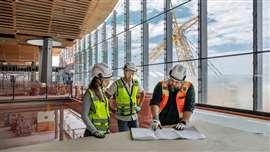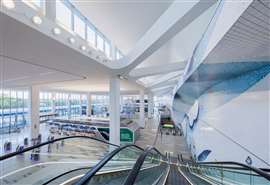Skanska USA positive about costs, supply chains, market conditions
29 February 2024
Skanska USA, an arm of Sweden-based multinational construction and development firm, released its market trends webinar earlier this week, and – despite environmental and geopolitical frustrations – US leadership is spoke about improving supply chains, material costs, and labour shortages
 Skanska workers at the Portland International Airport (PDX) Terminal Core Redevelopment
Skanska workers at the Portland International Airport (PDX) Terminal Core Redevelopment
Anita Nelson, chief strategy officer for Skanska USA Building, was joined by colleagues Steve Stouthamer (executive VP of project planning), Kez Gneiting (national supply chain manager) and partner Jay Bowman of FMI Consulting on February 27 for the group’s market outlook presentation.
While recognising the issues that have hampered the industry globally and domestically, the report and presentation largely amplified the positives in what Skanska believes could be a productive year in the US. Earlier this month, parent entity Skanska announced a record backlog at its annual meeting.
Stouthamer wrote in the introduction to the report, “Since the beginning of the economy’s rebound… from the Covid-19 pandemic, the construction industry has experienced unprecedented cost escalation and supply chain disruption.”
However, economic data suggested this was easing and this has led to more manageable business operations for contractors.
“With elevated interest rates impacting project financing in multiple sectors and remote work stymieing the commercial office market, projects that are proceeding are benefiting with improved, predictable subcontractor bid results,” said Southamer. “Particularly in the civil, structural and architectural trades, our local preconstruction teams are seeing more interested bidders given the pullback in the aforementioned sectors and, as a result, more competitive bids (in general) coming in at or below the estimated cost.”
Stouthamer highlighted two concerns: mechanical, electrical, and pluming (MEP) costs and regional bid escalation.
“The significant growth in data centres, tech manufacturing, EV-related facilities and pharmaceutical construction continues to strain the MEP trades,” he said. “Pricing levels in those trades continue to climb, and supply chain issues persist, particularly in electrical switchgear and emergency generator manufacturing.”
Some regions are still experiencing labour strains due to escalated volume in local growth sectors, which impacts their bidding environment and construction costs, and no region was anticipating more price hikes than Orlando, Florida.
“The competition for labour, specifically those in higher-skilled trades such as electrical, HVAC, and plumbing, has caused dramatic increases in costs for these construction services,” Tom Stickrod, Skanska USA VP of preconstruction in Orlando. “Companies who perform these trades weigh risks associated with being unable to perform the work they are contracted to do and are pricing work accordingly. While commodity-driven components have levelled off, wages have increased, and anticipated production has fallen.
“Coupled with a lack of qualified firms able to perform large projects,” he continued, “the cost for these trades has risen to levels that would have seemed absurd just a year ago. We anticipate market correction, but this does not seem likely in the near future.”
 Skanska designed and built the new Terminal B building at LaGuardia Airport in New York (Image courtesy of Skanska)
Skanska designed and built the new Terminal B building at LaGuardia Airport in New York (Image courtesy of Skanska)
Supply chain’s global woes may finally improve
Kez Gneiting provided an outlook for supply chains, and while there’s still a lot to track, she believed conditions were on the up.
“On a global level,” said Gneiting, “we’ve seen some disruptions to two key shipping routes, [as] the Red Sea crisis has impacted the Suez Canal.”
The Red Sea crisis refers to an ongoing multinational conflict near Yemen. Since October of last year, US, UK, and Israel military forces have been in conflict with Iran-backed Houthi rebels in the Arabian Peninsula country. Construction Briefing’s Neil Gerrard discussed the conflict in January.
The exchange of fire and risk of piracy has forced many shipping companies to find another route through the area.
“Some shipping companies have opted to route their shipments around the Cape of Good Hope, [South Africa],” said Gneiting. She noted the route adds 10 extra days shipping time. “We’re talking an added US$1 million in fuel costs per roundtrip and increased insurance costs.”
Gneiting said that, largely, Skanska USA has experienced positive changes with supply chain. “Many construction, equipment, [and] material manufacturers have been able to improve their supply chain resiliency by implementing both dual and regional North American source as part of a reaction to the pandemic period supply chain disruptions,” she said. “With that in mind, we would say the overall status of the commercial construction supply chain is generally positive.”
 Skanska USA has previously rehabilitated the approaches on the Brooklyn Bridge
Skanska USA has previously rehabilitated the approaches on the Brooklyn Bridge
Manufacturing construction showing ‘strongest growth’ in 25 years
Jay Bowman of FMI discussed some of Skanska USA’s specific data from 2023 and made projections for the future. He noted construction segments were flat, which, he said, means some activities increased and others decreased.
One of the most robust sectors last year and in recent memory, according to Bowman, is manufacturing construction.
“Manufacturing was not the largest construction segment in the US [even] a couple years ago, but we’ve seen roughly about an 80% increase in manufacturing construction spending last year,” he said, “which followed about a 50% to 60% increase the year before.”
Bowman added the figures are historic, from his point-of-view. “Probably the strongest growth in manufacturing construction, or any segment, that I’ve seen in my 25-years plus of tracking these markets,” he said.
Skanska USA’s megaprojects underway
Bowman gave credit to Skanska USA’s involvement on megaprojects as a big driver of activity.
“A lot of the growth that we’ve experienced over the last seven to ten years has come in the form of megaprojects,” he confirmed, noting ‘mega’ applies to schemes worth a billion dollars or more. “We’re seen a proliferation of these over the last several years.
“You could argue that almost… all of the growth… over the last couple of years [could] be attributed to megaprojects,” he said, noting Skanska USA is working on several civil and building component projects from coast to coast.
The largest benefit of megaprojects, Bowman said, is the vacuum-type effect it can have in other regions and segments. “These things just become a vacuum for labour materials,” he said. “They start to pull in things from surrounding states.”
STAY CONNECTED



Receive the information you need when you need it through our world-leading magazines, newsletters and daily briefings.
CONNECT WITH THE TEAM








